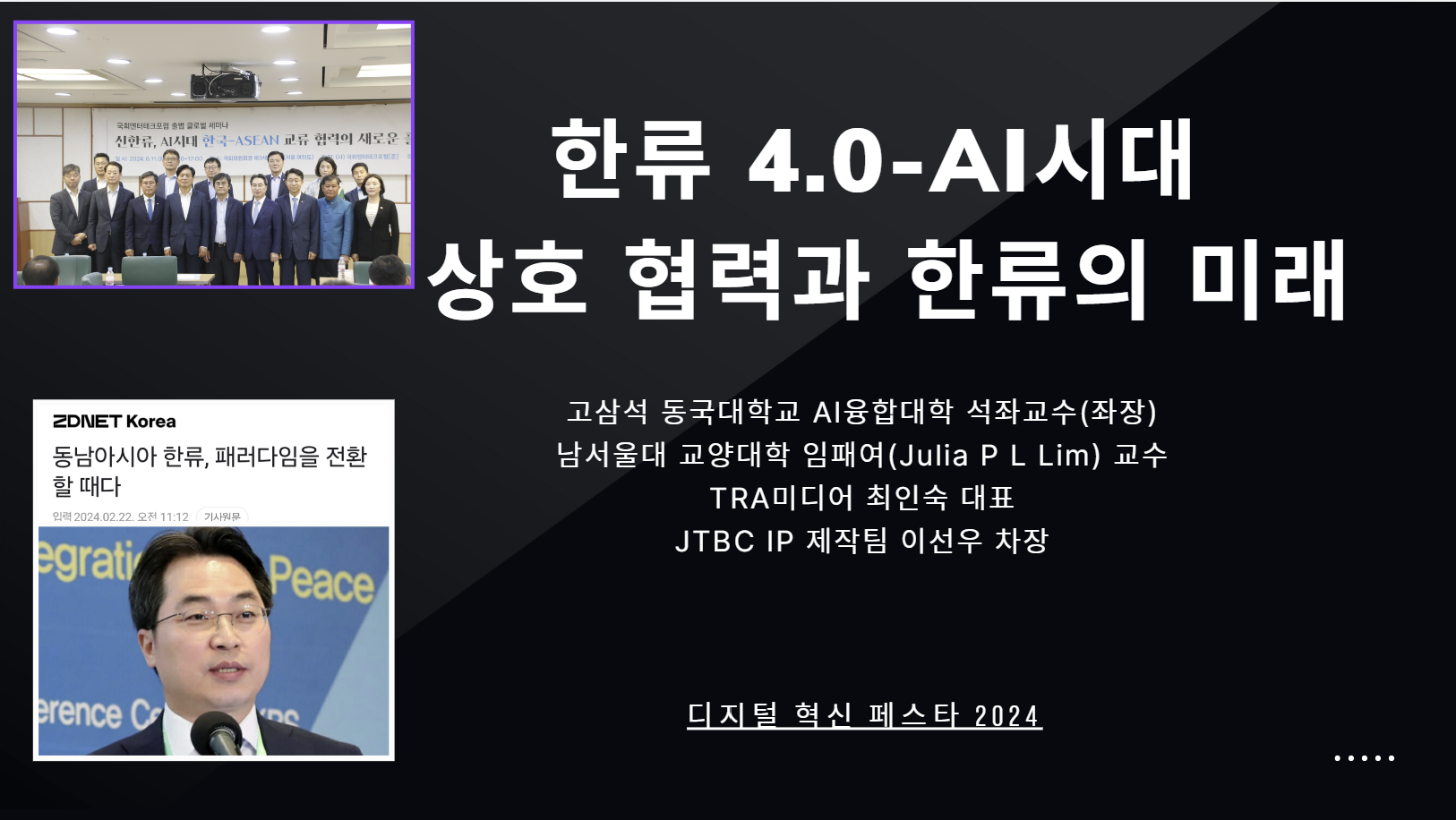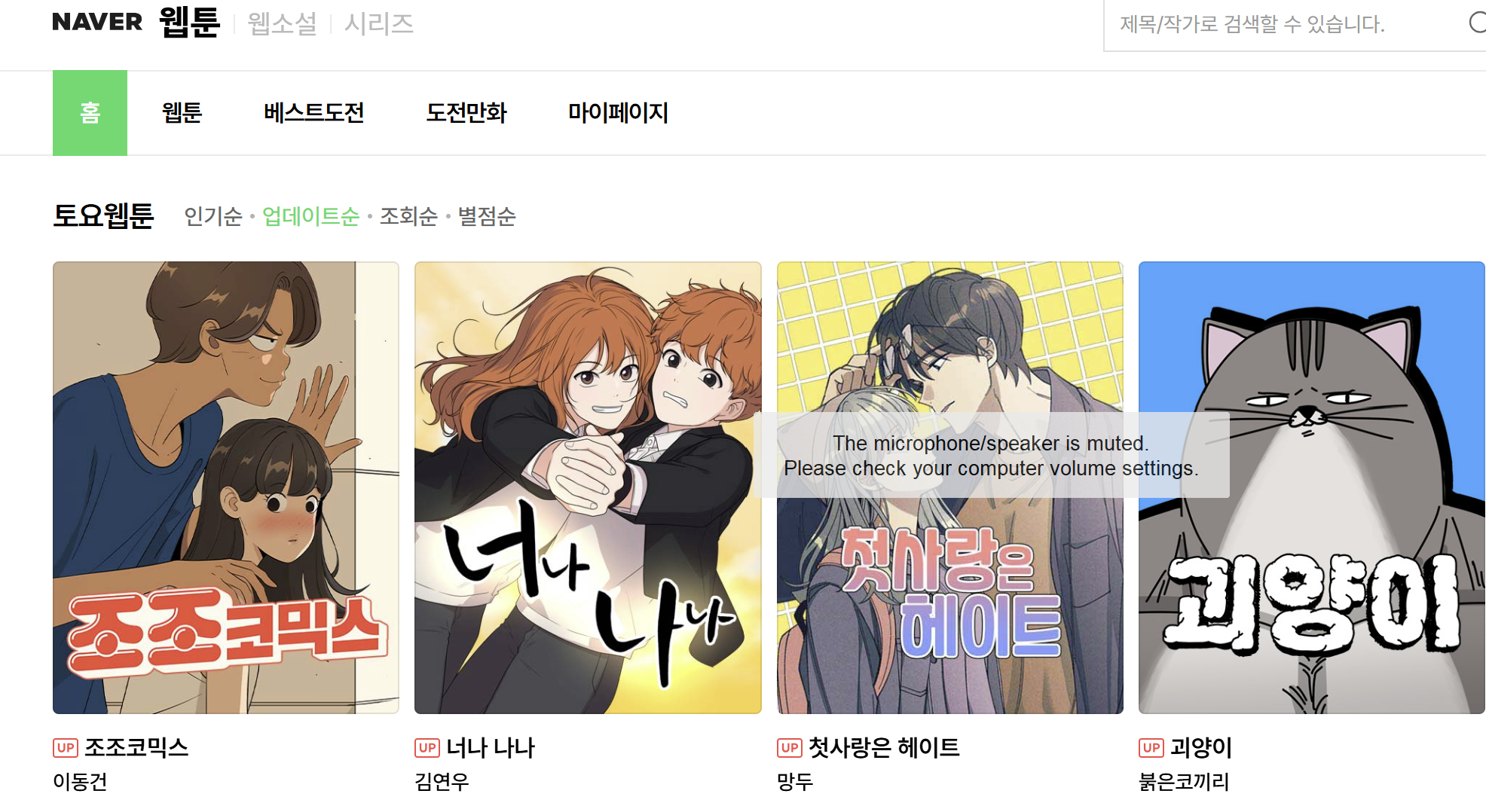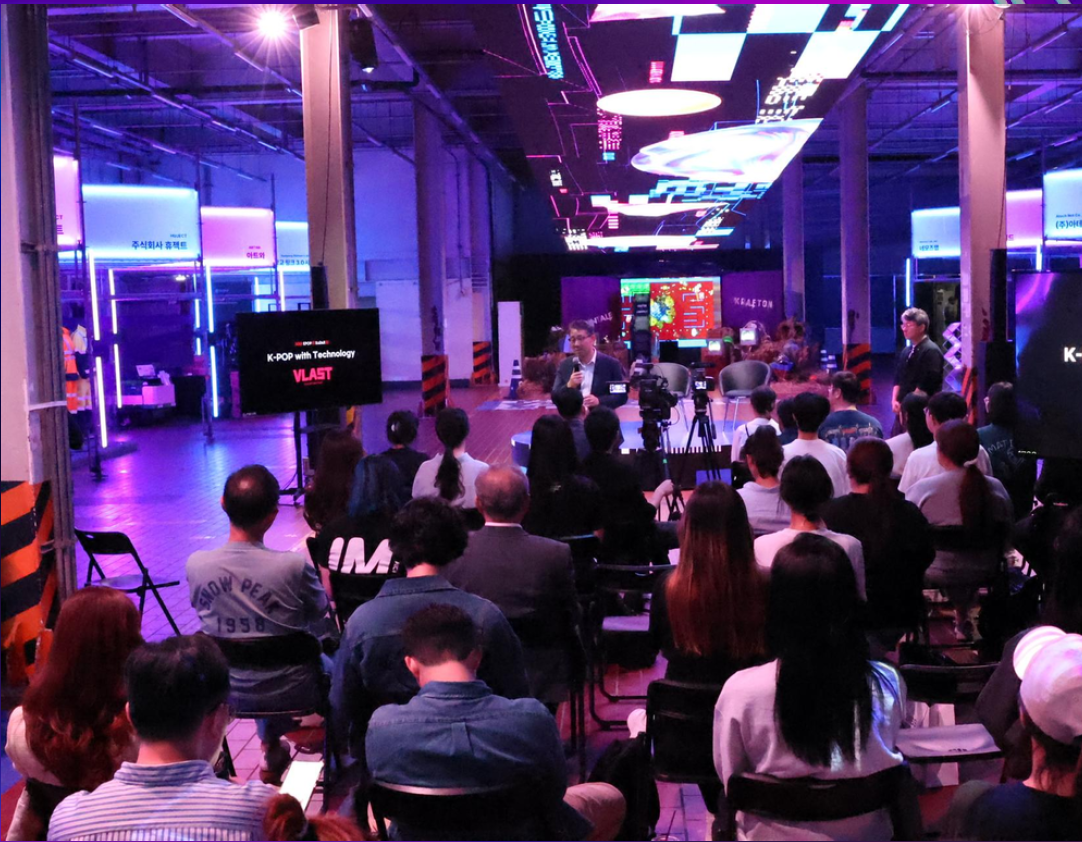[고삼석 칼럼] 엔터테인먼트와 기술의 결합이 만들 한류의 미래(The future of the Korean Wave is shaped by the marriage of entertainment and technology)
글/고삼석 동국대 AI융합대학 석좌교수·전 방통위 상임위원(Samseog Ko, Distinguished Professor, School of AI Convergence, Dongguk University KCC(Korea communications commission) former commissioner)
"예술의 역사는 기술의 역사다"(The history of art is the history of technology). 인간과 기술, 그리고 예술의 상호작용을 연구한 체코 출신 미디어 철학자 빌렘 플루서(Vilem Flusser)에 따르면 예술은 단순한 미적 표현이 아니라 창작자가 사용하는 '기술이나 도구'에 따라서 만들어지고 변형되는 존재라고 규정할 수 있다. 인쇄술의 발명으로 지식의 생산이나 전파 방식이 바뀌고, 사진 기술의 등장으로 이미지 제작 방식에 근본적인 변화가 초래된 것이 대표적인 예이다.
20세기는 대중 미디어(Mass Media)의 시대였고, 미디어는 다양하고 새로운 형태의 콘텐츠를 끊임없이 만들어냈다. 지난 세기에 미디어 및 콘텐츠 산업의 눈부신 발전에 가장 큰 영향을 미친 요인을 꼽으라고 한다면 단연 기술(Technology)의 발전이라고 말할 수 있다. 특히 디지털 기술의 발전과 콘텐츠 산업 발전은 '동전의 양면'이라고 표현할 수 있다. 그만큼 기술은 미디어 및 콘텐츠 산업에 심대한 영향을 끼쳤다.
"The history of art is the history of technology"
According to Vilem Flusser, a Czech media philosopher who studied the interaction between humans, technology, and art, art is not just an aesthetic expression, but something that is created and transformed by the "techniques or tools" used by its creators.
The invention of the printing press changed the way knowledge was produced and disseminated, and the advent of photography fundamentally altered the way images were created.
The 20th century was the age of mass media, and media constantly created new and diverse forms of content. If we had to name the single most influential factor in the remarkable development of the media and content industry in the last century, it would be the advancement of technology.
In particular, the development of digital technology and the development of the content industry can be described as two sides of the same coin. Technology has had a profound impact on the media and content industry.
미디어 기술의 역사는 콘텐츠 기업의 역사
미디어 기술의 발전은 제작 프로세스, 콘텐츠 형태뿐만 아니라, 이용자들의 미디어 이용행태, 최종적으로 콘텐츠 산업의 구도를 크게 변화시켰다. 실제로 콘텐츠 기업의 역사는 미디어 기술 발전의 역사라고 해도 과언이 아니다. 인쇄 매체에서 전파 매체로, 라디오에서 TV로, 흑백TV에서 컬러TV로, 아날로그 방송에서 디지털 방송으로 발전은 미디어 및 콘텐츠 기업의 흥망성쇠와 맥락을 같이 한다. 그 자체가 산업과 시장의 역사이기도 하다. 드라마와 가요에서 시작하여 영화, 웹툰 등 다양한 장르의 K콘텐츠를 중심으로 형성, 발전된 한류의 역사도 크게 다르지 않다.
1990년대 후반 '컬러TV 시대' 아시아에서 싹을 틔운 한류는 '인터넷 시대', '모바일 시대'를 거치면서 전 세계로 확산되었고, 코로나 팬데믹을 전후로 한 'OTT시대'에 진입하면서 최고의 전성기를 누리고 있다. 물론 그 단계들을 '칼로 무를 자르듯' 획일적으로 구분할 수 있는 것은 아니다. 바통을 이어받으며 앞으로 나아가는 '이어달리기'를 하듯, 양적 축적이 질적 변화로 이어지는 양질 전환의 법칙처럼 한류는 끊임없이 진화, 발전해 왔다.
The history of media technology is the history of content companies
The evolution of media technology has significantly changed the production process, the form of content, the way people consume media, and ultimately the structure of the content industry. In fact, the history of content companies is the history of the evolution of media technology.
The evolution of print media to radio, radio to TV, black-and-white TV to color TV, analog broadcasting to digital broadcasting, and so on, has been accompanied by the rise and fall of media and content companies.
It is also the history of an industry and a market. The history of the Korean Wave, which started with dramas and songs and developed around various genres of K-content such as movies and webtoons, is no different.
The Korean Wave, which sprouted in Asia in the late 1990s during the "color TV era," spread across the globe through the "the era of Internet era" and "The of mobile" and is currently enjoying its peak as it enters the "OTT era" around the coronavirus pandemic.
Of course, the stages cannot be categorized uniformly, like cutting a radish with a knife. Just like the law of quantitative accumulation leading to qualitative change, Hallyu has been constantly evolving and developing, just like the 'carrying forward' of a tradition.
컬러TV 시대, 한류의 태동
연구자에 따라서 약간의 차이는 있으나, 정책 영역에서 논의를 바탕으로 분류하면 한류의 발전 과정은 한류1.0을 시작으로 현재 한류4.0 단계에 들어와 있다고 할 수 있다. 학계 연구자들이나 현업에 종사하고 있는 이들의 견해도 크게 다르지 않다.
일반적으로 한류1.0(1997~2000년대 초반)은 중화권에서 국내 TV드라마 '사랑이 뭐길래'(1997), '별은 내 가슴에'(1997)의 대히트를 시작으로 태동하기 시작했다. 이어서 한류2.0(2000년대 초반~2010년대 초반)은 '겨울연가'(2003), '대장금'(2005) 등 TV드라마와 더불어 '동방신기'(2004), '소녀시대'(2007) 등 아이돌 그룹이 해외에서 크게 인기를 얻고 팬덤이 형성되면서 중동과 남미 지역까지 점차 확산되기 시작했다.
그러나 한류1.0(1997~2000년대 초반)과 한류2.0(2000년대 초반~2010년대 초반) 단계에서는 TV라는 전파 미디어를 중심으로 콘텐츠가 제작 및 공급되고, 이용자들의 이용이 이뤄짐에 따라서 (중동과 남미 지역에서 한류가 일어났음에도 불구하고) 아시아 지역을 넘어서 글로벌로 크게 확산되기에는 한계가 있었다. 콘텐츠의 장르 또한 드라마와 가요 중심이었고, 일부 영화가 '아시아권' 한류 붐 조성에 기여한 정도였다.
The Color TV Era, the Beginning of the Korean Wave
Although there are some differences depending on the researcher, if we classify the development process of the Korean Wave based on discussions in the policy arena, it can be said that it started with Hallyu 1.0 and is currently in the Hallyu 4.0 stage. The views of academic researchers and those working in the field are not much different.
In general, Hallyu 1.0 (1997 to the early 2000s) began to take off in Greater China with the massive success of the Korean TV dramas "What is Love" (1997) and "A Star in My Heart" (1997). Then, Hallyu 2.0 (early 2000s - early 2010s) began to spread gradually to the Middle East and South America as TV dramas such as "Winter Sonata" (2003) and "Dae jang geum" (2005), as well as idol groups such as TVXQ (동방신기)(2004) and Girls Generation(2007) gained great popularity and fandom overseas.
However, Hallyu 1.0 (1997 - early 2000s) and Hallyu 2. 0 (early 2000s to early 2010s), however, as content was produced, supplied, and used by users centered on the broadcast media of television, there was a limit to the global spread of the Hallyu beyond Asia (despite the rise of the Hallyu in the Middle East and South America). The genre of content was also centered on dramas and songs, with some movies contributing to the "Asian" Hallyu boom.
YouTube, OTT와 한류의 전 세계적 확산
2000년 전후로 방송과 통신의 융합이 글로벌 트렌드로 나타났다. 디지털TV로 전환 및 제작 시설과 장비의 디지털화가 본격 시작되었으며, 콘텐츠 또한 고화질(HD) 제작이 자리를 잡기 시작하였다. 특히, 2010년 4세대 이동통신(LTE) 시대가 본격 열리면서 '손 안의 방송국'이라고 불린 모바일 기기와 소셜 미디어(Social Media, 이하 ‘SNS’) 기반의 한류3.0(2010년대 초반~2019년) 시대가 개막했다.
'Personal Media' 시대의 도래는 한류 콘텐츠에 대한 전 세계 이용자들의 접근 및 이용을 용이하게 함으로써 한류 확산의 기폭제 역할을 했다. BTS, 블랙핑크의 글로벌 팬덤 형성도 2000년 이후 '글로벌 IT붐', 특히 유튜브(YouTube), 페이스북(Facebook), 트위터(Twitter, 현재 X) 등 SNS의 폭발적 성장과 흐름을 같이 했다.
유튜브를 통해 전 세계적인 히트를 기록한 싸이의 '강남스타일'(2012) 뮤직 비디오가 대표적인 수혜자라고 할 수 있다. 싸이의 강남스타일 뮤직 비디오는 영상 공개 161일만에 유튜브 조회수 10억 뷰를 달성하면서 유튜브의 역사를 새롭게 기록하였다. 2023년 12월 30일에는 K팝 최초로 유튜브 조회수 50억 뷰를 돌파했다. 유튜브라는 글로벌 플랫폼이 있었기 때문에 '강남스타일'의 대성공이 있었다는 평가에 고개가 저절로 끄덕여진다.
"SNS 덕분에 BTS가 성공할 수 있었다." BTS를 키운 하이브(당시 빅히트엔터테인먼트) 방시혁 대표의 말이다. 방대표는 '2017년 엠넷 아시아 뮤직어워드 시상식 기조연설'에서 "최근 몇 년간 소셜 미디어가 대두되고 온라인 플랫폼이 다변화되면서 음악 산업의 축이 거세게 흔들렸다"고 말했다. 결론적으로 "BTS는 SNS가 기존 미디어의 흐름을 바꾼 좋은 예"라고 설명하였다. "BTS의 성공 이유를 '컨셉 스토리텔링'이 아닌 SNS로 꼽은 것은 편협하다"는 비판도 일리가 있지만, SNS라는 새로운 미디어의 등장과 확산이 BTS의 글로벌 성공을 뒷받침했다는 것은 부정할 수 없는 사실이다.
코로나 팬데믹을 거치면서 한류4.0(2020년 이후~) 시대에 진입하였다. 코로나 팬데믹으로 인해 사회경제적 봉쇄(Shutdown)가 장기간 지속되었지만, 오히려 모바일 기반의 비대면 경제 및 문화 소비의 시대가 활짝 열리는 계기가 되었다. 한류 발전의 역사 측면에서 보면 커다란 전환점이 되었다고 할 수 있다. 한류4.0 시대는 넷플릭스(Netflix)로 대표되는 OTT와 넷플릭스 오리지널 '오징어게임'(2021)을 빼놓고 얘기할 수 없다. OTT의 '주류 미디어화'는 당연히 지상파방송, 케이블TV 등 레거시 미디어의 쇠퇴와 동시에 나타난 현상이다. 즉 콘텐츠 제작과 유통, 이용 측면에서 미디어 시장의 주류 교체가 일어났다.

넷플릭스 성장전략의 핵심은 ‘CTS 모델’, 즉 콘텐츠(C)와 테크놀로지(T), 그리고 가입(S)을 혼합한 모델이다. 오리지널 콘텐츠와 첨단 테크놀러지의 결합을 기반으로 가입자를 확보하는 사업모델 혁신으로 미디어 시장의 구도를 근본적으로 재편하고 있다. 넷플릭스의 성장을 이끈 세 가지 요소 중 지금의 ‘글로벌 미디어 제국’을 만드는 데 가장 큰 역할을 한 것이 테크놀로지라는데 이의를 제기하는 사람은 없을 것이다.
기술적인 측면 외에 콘텐츠 유통 플랫폼으로서 넷플릭스의 가장 큰 장점은 3억 명에 가까운 전 세계 시청자들을 대상으로 콘텐츠를 동시에 제공할 수 있다는 점이다. 즉 넷플릭스가 진출해 있는 지역이라면 실시간으로 동일한 콘텐츠 공급과 콘텐츠에 대한 반응도 실시간으로 확인이 가능하다. 특히 넷플릭스 이용자들은 SNS를 통하여 자신들의 시청 경험을 공유하면서 콘텐츠에 관한 정보를 빠르게 확산시킴으로써 K콘텐츠가 ‘글로벌 흥행작’이 되는데 큰 기여를 하였다. 오징어게임 이외에 ‘지금 우리 학교는’(2022), ‘이상한 변호사 우영우’(2022), ‘더 글로리’(2022) 등이 이러한 공식을 충실하게 따르면서 글로벌 흥행작 대열에 합류하였다.
지금까지 살펴본 바에 따르면 "콘텐츠의 역사는 기술의 역사"라고 할 수 있을 정도로 미디어 환경의 변화와 콘텐츠의 혁신, 그리고 이용자의 이용행태 변화는 상호 밀접한 관계가 있다. 특히 모바일과 SNS의 확산, OTT의 주류 미디어화 등 미디어 기술의 발전과 한류의 세계적 확산이라는 시장 트렌드의 변화는 매우 긴밀한 관계를 보여주고 있다.
YouTube, OTT, and the Global Spread of the Korean Wave
Around 2000, the convergence of broadcasting and telecommunications emerged as a global trend. The transition to digital TV and the digitization of production facilities and equipment began in earnest, and high-definition (HD) content production began to take hold. In particular, the fourth-generation mobile communication (LTE) era began in earnest in 2010, ushering in the Hallyu 3.0 era (early 2010s to 2019), which was based on mobile devices called "stations in the palm of your hand" and social media (SNS). The advent of the "personal media" era served as a catalyst for the spread of Hallyu by facilitating global access to and consumption of Hallyu content.
The global fandom of BTS and BLACKPINK also coincided with the 'global IT boom' after 2000 and the explosive growth of social media, especially YouTube, Facebook, and Twitter (now X). Psy's "Gangnam Style" (2012) music video, which became a global hit through YouTube, is a typical beneficiary. Sai's Gangnam Style music video made YouTube history when it reached 1 billion YouTube views in 161 days after its release.
On December 30, 2023, it became the first K-pop video to reach 5 billion YouTube views. There's a nod to YouTube as a global platform for the success of "Gangnam Style. "Social media made BTS successful." This is what Bang Si-hyuk, CEO of Hive (then Big Hit Entertainment), the company that raised BTS, says. "In recent years, the music industry has been shaken by the rise of social media and the diversification of online platforms," he said in his keynote speech at the 2017 Mnet Asia Music Awards ceremony.
"BTS is a great example of how social media has changed the course of traditional media," he concluded. While there is a valid criticism that "it is narrow-minded to attribute BTS's success to social media rather than conceptual storytelling," it is undeniable that the emergence and spread of social media supported BTS's global success. We have entered the Hallyu 4.0 (2020 and beyond) era through the coronavirus pandemic.
Although the pandemic led to a prolonged socioeconomic shutdown, it also ushered in an era of mobile-based, non-face-to-face economic and cultural consumption. It was a major turning point in the history of the Korean Wave. The Hallyu 4.0 era cannot be talked about without mentioning OTT represented by Netflix and the Netflix original "Squid Game" (2021).
The "mainstream mediaization" of OTT is a phenomenon that has appeared simultaneously with the decline of legacy media such as terrestrial broadcasting and cable TV, which has led to a mainstream shift in the media market in terms of content production, distribution, and usage. The core of Netflix's growth strategy is the 'CTS model', a model that blends content (C), technology (T), and subscription (S). The company is fundamentally reshaping the media marketplace by innovating its business model to acquire subscribers through a combination of original content and advanced technology.
Of the three factors that have driven Netflix's growth, no one would argue that technology has played the biggest role in creating the "global media empire" it is today. Aside from technology, Netflix's biggest advantage as a content distribution platform is its ability to simultaneously deliver content to nearly 300 million viewers around the world, which means that wherever Netflix is present, the same content is available in real time, and the reactions to it are also available in real time.
In particular, Netflix users share their viewing experiences through social media and quickly spread information about the content, making a significant contribution to making K-content a 'global box office hit'.

In addition to "Squid Game," "We are all dead" (2022), "Extraordinary Attorney Woo" (2022), and "The Glory" (2022) have joined the ranks of global box office hits by faithfully following this formula. As we have seen, "the history of content is the history of technology," and changes in the media environment, innovations in content, and changes in user behavior are closely interrelated. In particular, the development of media technology, such as the spread of mobile and SNS and the mainstream mediaization of OTT, and changes in market trends, such as the global spread of the Korean Wave, show a very close relationship.
생성AI가 바꿀 콘텐츠 산업과 한류의 미래는?
2022년 11월 오픈AI의 챗GPT 등장 이후 "창작 능력을 갖춘 인공지능 기술"로 정의되는 생성AI 시대가 개막되었다. 전문가들은 AI를 인터넷 발명 이후 가장 중요한 기술발전이라고 본다. AI가 주목을 받는 이유는 AI 기술이 모든 산업 영역에 적용되는 범용기술(GPT)이기 때문이다. 실제로 금년 초 CES2024나 MWC2024의 화두는 'AI for All' 또는 ‘All for AI’, 즉 AI가 전 산업 영역으로 확산되고 활용되는 현상이었다.
생성AI는 콘텐츠 창작을 비롯한 제작 환경과 플랫폼 환경에 큰 영향을 미칠 것으로 전망되고 있다. AI는 음악의 창작과 제작 영역, 영화와 드라마 제작 현장을 넘어 유통 영역까지 개입하고 있다. 미국 엔터테인먼트 전문 매체 버라이어티(Variety)는 최근 콘텐츠 제작에서 생성AI 솔루션 툴의 사용 빈도가 급속하게 증가하고 있는데, 이는 “인터넷 30년 역사 중 가장 빠른 확산 속도”라고 분석하였다.
챗GPT 개발사인 미국 오픈AI가 2024년 2월 15일 공개한 AI 서비스 소라는(Sora)는 간단한 명령어만 입력하면 누구나 고화질의 동영상을 제작할 수 있는 시스템으로 세상을 깜짝 놀라게 했다. 10월 6일 메타가 공개한 생성AI 모델 무비 젠(Movie Gen)은 이용자 맞춤형 동영상 제작 등 강력한 기능으로 주목을 받고 있다. 또한 금년도 디지털 서비스 전문 플랫폼 리플라이 AI(Reply AI)가 개최한 ‘AI 필름 페스티벌’에는 한국 포함 전 세계 60개국에서 1000편 이상의 작품이 출품되었다. 두바이국제AI영화제, 부천국제판타스틱영화제(BIFAN)를 비롯하여 세계 각국 영화제에 ‘AI 부문’이 속속 신설되고 있다.
지난 9월 SM엔터테인먼트는 첫 버추얼 아티스트 ‘나이비스’를 데뷔시켰다. SM엔터테인먼트는 “AI 보이스 기술로 구현되는 목소리, 생성AI로 제작되는 콘텐츠 등을 통해 음악뿐만 아니라 웹툰, 게임, 브랜드 컬래버레이션 등 IP(지식 재산) 유니버스를 확장할 계획”이라고 발표하였다.
How will Generative AI change the content industry and the future of the Korean Wave?
The era of Generative AI, defined as "artificial intelligence technology with creative capabilities," began in November 2022 with the launch of OpenAI's ChatGPT. Experts consider AI to be the most important technological development since the invention of the internet.
The reason why AI is gaining traction is because it is a general purpose technology (GPT) that can be applied to all industries. In fact, the buzzword at CES2024 and MWC2024 earlier this year was "AI for All" or "All for AI," the phenomenon of AI spreading and being utilized in all industries. Generative AI is expected to have a major impact on the production environment and platform environment, including content creation.
AI is entering the realm of music creation and production, movie and drama production, and even distribution. U.S. entertainment publication Variety recently analyzed the rapid increase in the use of generative AI solutions in content creation, calling it "the fastest rate of proliferation in the Internet's 30-year history."
Sora, an AI service released on February 15, 2024 by US-based OpenAI, the developer of ChatGPT, surprised the world with a system that allows anyone to create high-quality videos by entering simple commands.
Movie Gen, a generative AI model released by Meta on October 6, has been attracting attention for its powerful features, including the ability to create customized videos. In addition, this year's AI Film Festival, organized by Reply AI, a platform specializing in digital services, attracted more than 1,000 entries from 60 countries around the world, including Korea.
AI sections are being established at film festivals around the world, including the Dubai International AI Film Festival and the Bucheon International Fantastic Film Festival (BIFAN). In September, SM Entertainment debuted its first virtual artist, NAVIS. SM Entertainment said, "Through voices realized by AI voice technology and content produced by generative AI, we are able to create a sound

콘텐츠 제작에 최적화된 AI 기술의 고도화, 막대한 투자에 상응하는 성과를 거둘 수 있는 새로운 비즈니스 모델 개발 등이 수반되어야 하는 과제가 있는 것도 사실이다. 그렇다고 거대한 '쓰나미'처럼 밀려오는 생성AI 시대의 도래를 콘텐츠업계가 거부하거나 부정할 수는 없다. 엔터와 테크의 결합은 ‘예정된 미래’이기 때문이다.
미국의 대표적인 AI 콘텐츠 스튜디오인 런웨이(Runway)의 공동 창업자이자 CEO인 크리스토발 발렌수엘라(Cristo ́bal Valenzuela)는 "우리는 아티스트, 크리에이터, 스튜디오에 작업 환경을 불어넣는 새롭고 강력한 도구(AI)를 제공하기 위해 노력하고 있다"며 "예술의 역사는 곧 기술의 역사이다. 그러나 생성AI로 인한 (본격적인) 변화는 아직 시작되지도 않았다"라고 설명하였다.
그렇다면 생성AI는 한류에 어떤 영향을 미치고, 우리는 어떻게 대응해야 할까? 이와 관련된 첫 번째 질문, 생성AI 시대의 도래는 한류 확산에 긍정적일까? 부정적일까?
콘텐츠 전문가들은 대체로 생성AI 시대의 도래가 한류의 외연을 더욱 확장시킬 것으로 전망하고 있다. 앞서 살펴본 AI 기반 버추얼 아티스트를 활용한 버추얼 콘텐츠 제작, 온라인 공간에서 아티스트와 이용자(관객)들이 상호작용하는 인터랙티브 콘텐츠 및 서비스도 새롭게 등장하고 있다. 실제로 K팝과 K게임은 가상공간에서 협업하여 상당한 성과를 거두고 있다. 김종민 부천국제판타스틱영화제 XR 큐레이터는 “디지털 기술의 발전이 콘텐츠의 많은 영역을 바꿀 것이다. 콘텐츠 산업계가 재편되며 대규모 확산 배포의 경제에서 ‘소규모 몰입형 개인화 경제’로 발전할 것”이라고 전망하였다.
네이버웹툰은 ‘스토리 테크’(Story Tech) 기술을 도입하였다. 웹툰 제작에 AI를 활용하고, 소셜미디어를 통해서 웹툰이 해외에 소개되면서 전체 이용자의 80%가 해외에서 유입되고 있다. 또한 저작권 보호를 전제로 웹툰 이용자 스스로 AI기술(툰필터) 통해서 콘텐츠를 변형하도록 만드는 서비스가 폭발적 인기를 끈 사례도 주목할 필요가 있다. 네이버웹툰은 창작자, 사업자, 이용자 모두에게 도움이 되는 방향으로 AI 기술을 활용할 계획이라고 발표하였다.
생성AI 기술의 발전으로 인해 언어 장벽이 낮아지는 것도 한류 확산에 긍정적 영향을 기대하게 만든다.
챗GPT를 비롯한 대형언어모델(LLM) 기반 서비스가 등장하면서 실시간 오디오 번역이 가능, 콘텐츠 재제작 및 이용에 있어서 장벽이 현저하게 낮아지고 있다. 이로 인해 한류 확산의 속도 및 지역적 범위도 훨씬 넓어질 것으로 기대가 된다. 실제로 하이브는 AI 오디오 기업 수퍼톤의 ‘다국어 발음 교정 기술’과 ‘보이스 디자이닝 기술’을 활용해 한국어·영어·일어는 물론 스페인어·중국어·베트남어 등 6개국 언어로 신곡을 발표하였다. 하이브는 “이들 6개국 언어는 전 세계 인구의 약 절반을 커버하고 있다”고 설명하였다.
While it is true that there are challenges, such as advancing AI technologies optimized for content creation and developing new business models that can pay off the huge investment, the content industry cannot deny the arrival of the generative AI era like a tsunami. The combination of entertainment and technology is the future.
As Cristo ́bal Valenzuela, co-founder and CEO of Runway, a leading AI content studio in the U.S., explained, "We are committed to providing artists, creators, and studios with new and powerful tools (AI) to infuse their working environment." "The history of art is the history of technology, and the (full-scale) change brought about by generative AI has not yet begun," he said.
So how will gen AI affect the Korean Wave, and how should we respond? The first question is: Is the arrival of generative AI positive for the spread of the Korean Wave? Or is it negative? In general, content experts believe that the arrival of generative AI will further expand the reach of the Korean Wave.
Virtual content creation using AI-based virtual artists and interactive content and services that allow artists and users (audiences) to interact in the online space are also emerging.
In fact, K-pop and K-games have collaborated in the virtual space and achieved significant results. Kim Jong-min, curator of XR at the Bucheon International Fantastic Film Festival, said, "The development of digital technology will change many areas of content. The content industry will be reorganized and evolve from an economy of large-scale diffuse distribution to a 'small-scale immersive personalization economy'."

NAVER Webtoon has introduced 'Story Tech' technology. It utilizes AI in webtoon production and introduces webtoons overseas through social media, with 80% of its users coming from overseas. It is also worth noting that a service that allows webtoon users to transform content through AI technology (toon filter) under the premise of copyright protection has exploded in popularity. NAVER Webtoon announced that it plans to utilize AI technology in a way that will benefit creators, businesses, and users alike.
The lowering of language barriers due to advances in generative AI technology is also expected to have a positive impact on the spread of the Korean Wave. With the emergence of large language model (LLM)-based services such as Chat GPT, real-time audio translation is possible, significantly lowering the barriers to re-creating and using content.
This is expected to increase the speed and geographic reach of the Korean Wave. In fact, Hive has released new songs in six languages, including Korean, English, and Japanese, as well as Spanish, Chinese, and Vietnamese, utilizing AI audio company Supertone's multilingual pronunciation correction technology and voice design technology. "These six languages cover about half of the world's population," Hive said.
두 번째 질문, 글로벌 플랫폼에 대한 의존도는 강화될 것인가, 약화될 것인가?
한류의 발전 과정에서 살펴본 것처럼, 2010년대 이후 한류가 전 세계적으로 확산될 수 있었던 배경은 유튜브, 페이스북, 넷플릭스와 같은 글로벌 인터넷 플랫폼의 역할이 절대적이었다. 생성AI 시대에도 이들 글로벌 플랫폼의 위상 및 영향력은 결코 줄어들지 않을 것이다. 최근 몇 년 동안 생성AI 기술에 대한 대규모 투자 및 기술 개발이 이들 기업 주도로 진행되고 있는 점을 고려한다면, 글로벌 거대 플랫폼의 지배력은 앞으로 더욱 강화될 것이라고 전망해도 크게 문제가 되지 않을 것이다.
최근 몇 년 동안 유튜브와 OTT 등 글로벌 플랫폼은 TV와 영화관 같은 전통 미디어의 역할을 대체해왔다. 특히 코로나 팬데믹 이후 그 속도가 점점 빨라지고 있다. 문화체육관광부와 한국국제문화교류진흥원이 발표한 ‘2023년 해외 한류 실태조사’ 결과를 보면, 해외 26개국 한국문화콘텐츠 경험자 2만5000명은 드라마(67.6%), 영화(70%)의 경우 넷플릭스의 이용 비중이 압도적이었다. 예능(67.6%), 음악(81.1%), 애니메이션(66.1%)은 유튜브를 통해 이용하는 비중이 크게 높았다. 한류 콘텐츠와 글로벌 플랫폼 간의 관계를 보면, 지금까지는 양자 간 Win-Win 관계라고 볼 수 있다. 그러나 글로벌 플랫폼에 대한 과도한 의존 현상은 한류 콘텐츠와 국내 제작 시스템의 ‘종속’ 논란을 불러일으키고 있다.
한류라는 강력한 ‘콘텐츠 파워’에 비해 글로벌 차원에서 콘텐츠를 유통시키는 플랫폼이 없다는 것, 즉 ‘플랫폼 파워’가 약하다는 것은 우리 콘텐츠 산업의 구조적 약점으로 볼 수 있다. 따라서 최소한 국내 OTT 가운데 하나 정도는 글로벌로 직접 진출해야 한다는 지적이 오래 전부터 있었다. 생성AI 시대에도 ‘한류의 지속 가능성’ 차원에서 절대적으로 필요한 전략이다. 국내 OTT 플랫폼이 해외로 직접 진출하여 콘텐츠 투자와 제작을 주도하고, 해외 판매도 담당하며, 현지 기업들과 전략적 제휴도 추진하면서 글로벌+로컬 차원의 디지털 콘텐츠 제작 및 유통망 역할을 해준다면 우리 콘텐츠의 글로벌 경쟁력은 훨씬 커질 것이다.
The second question is: Will the reliance on global platforms strengthen or weaken?
As we have seen in the development of the Korean Wave, the role of global internet platforms such as YouTube, Facebook, and Netflix has been essential to the global spread of the Korean Wave since the 2010s.
Even in the era of gen AI, these global platforms are unlikely to diminish in stature and influence. Given the large-scale investments and technology developments in gen AI in recent years, it is safe to assume that the dominance of these global giants will only get stronger in the future.
In recent years, global platforms such as YouTube and OTT have been replacing the role of traditional media such as TV and movie theaters, especially since the coronavirus pandemic.
According to the '2023 Overseas Hallyu Survey' released by the Ministry of Culture, Sports, and Tourism and the Korea Culture Exchange, 25,000 people in 26 overseas countries who have experienced Korean cultural contents overwhelmingly used Netflix for dramas (67.6%) and movies (70%). For entertainment (67.6%), music (81.1%), and animation (66.1%), YouTube was the most popular platform.
The relationship between Hallyu content and global platforms has been a win-win situation so far. However, the over-reliance on global platforms has led to controversy over the "subordination" of Hallyu content to the domestic production system.
Compared to the strong 'content power' of Hallyu, the lack of platforms that distribute content on a global scale, or 'platform power', can be seen as a structural weakness of the Korean content industry. Therefore, it has long been pointed out that at least one of the domestic OTTs should directly enter the global market.
This is an absolutely necessary strategy for the sustainability of the Korean Wave even in the era of GENE AI. If a domestic OTT platform goes directly overseas to lead content investment and production, overseas sales, and strategic alliances with local companies, acting as a global + local digital content production and distribution network, the global competitiveness of Korean content will be much greater.
세 번째 질문, 생성AI 기반 소셜 비디오 시대의 도래에 따른 한류의 대응 전략은?
미국 엔터테인먼트 전문 매체 버라이어티는 영상(Video) 시장이 지상파(Broadcast)가 방송을 독점하던 시기를 지나 유료방송(Cable)이 방송 플랫폼을 주도하던 시기를 마감하고 OTT 시대로 진입한 지 10년(2010~2020년)이 지났으며 이제 ‘소셜 비디오(Social Video) 시대’를 맞이하고 있다고 분석하였다. 소셜과 비디오의 합성어인 소셜 비디오는 소셜 미디어(SNS)의 기능과 비디오의 기능이 합쳐진 서비스를 의미한다. 소셜 비디오는 SNS 상에서 참여 활동을 유도하고 이용자들의 관심을 끌기 위해 특별히 제작된 짧은 형태의 비디오라고 할 수 있다. 동영상을 손쉽게 만들 수 있도록 도와주는 생성AI 툴의 등장은 소셜 비디오 시대를 앞당기고 있다.
국내외에서 숏폼 이용량이 크게 늘어나는 것 등을 근거로 소셜 비디어 시대가 본격 개막되었다고 보는 전문가들도 적지 않다. 한류의 전 세계적 확산 과정에 유튜브, 페이스북, 트위터 같은 SNS가 끼친 막대한 영향을 고려할 때, 소셜 비디오 시대의 개막은 한류의 미래에 상당한 영향을 미칠 중요한 변수로 보아야 한다.
최근 프리사이즈TV(Precise TV)가 미국 2~12세 어린이(알파 세대)의 동영상 소비습관을 분석한 보고서(2024 Precise Advertiser Report-Kida)를 보면, 이들 세대는 TV 프로그램 보다는 소셜 비디오와 이용자 제작 콘텐츠를 더 많이 이용하는 것으로 나타났다. 알파 세대는 2024년 소셜 비디오를 시청하는 데 총 5.87시간을 사용한데 반해 스트리밍 서비스는 5.48시간 소비할 것으로 예상하였다.
2013년 이후 출생한 알파 세대가 10대가 됨에 따라서 미디어 & 엔터테인먼트업계는 이들의 소비 성향을 예의 주시하고 있다. 향후 10년 간 미디어 플랫폼의 변화를 알파 세대가 주도할 가능성이 크기 때문이다. 이 조사에서 틱톡은 알파 세대에게 가장 주목받는 SNS 서비스로 나타났다. 프리사이즈TV는 “미디어 산업은 급변하는 소비자 선호도와 기술 발전에 따라서 지속적인 변화를 겪을 것이며, 소셜 비디오와 이용자 제작 콘텐츠의 부상은 미디어 산업의 미래를 정의할 중요한 요소가 될 것”이라고 전망했다.
한국국제문화교류진흥원이 발표한 ‘2023년 해외 한류 실태조사’ 결과를 보면, 동남아시아 한류 이용자들은 주로 SNS를 통해서 한류와 관련된 정보를 검색하고, 유튜브와 넷플릭스(OTT)를 통해서 한류 콘텐츠를 이용한다. 그리고 다시 SNS에 자신들이 경험한 한류 관련 소식을 공유하면서 한류를 확산시켜 나가고 있는 것으로 나타났다. 이런 자료를 토대로 유추해 보면, 생성AI와 결합된 소셜 비디오 시대의 개막과 향후 한류 확산 트렌드는 일정 정도 상호 영향을 주고받으면서 전개된다고 보는 것이 합리적일 것이다.
The third question, what are the strategies for responding to the Hallyu wave as the era of social video based on generative AI arrives?
Variety, an American entertainment magazine, analyzed that the video market has been in the OTT era for 10 years (2010-2020), past the period when terrestrial broadcasting (Brocast) monopolized broadcasting, and cable broadcasting (Cable) dominated the broadcasting platform, and is now entering the 'Social Video era'. Social video, a combination of social and video, refers to services that combine the features of social media (SNS) and video.
Social videos are short-form videos created specifically to drive engagement and attract users' attention on social media. The emergence of creation AI tools that make it easy to create videos is advancing the era of social video. There are many experts who believe that the social video era has begun in earnest, based on the significant increase in short-form usage in Korea and abroad. Considering the huge impact of social media platforms like YouTube, Facebook, and Twitter on the global spread of the Korean Wave, the dawn of the social video era is a significant variable that will have a significant impact on the future of the Korean Wave.
A recent Precise TV report analyzing the video consumption habits of U.S. children ages 2-12 (Gen Alpha) (2024 Precise Advertiser Report-Kida) found that this generation is more likely to consume social video and user-generated content than TV shows. Gen Alpha is expected to spend a total of 5.87 hours watching social video in 2024, compared to 5.48 hours on streaming services.
As Gen Alpha, those born after 2013, enter their teens, the media and entertainment industry is closely watching their spending habits. This is because they are likely to drive the transformation of media platforms over the next decade.
The study found that TikTok is the most popular social media service among Gen Alpha. "The media industry will continue to undergo changes due to rapidly changing consumer preferences and technological advancements, and the rise of social video and user-generated content will be an important factor in defining the future of the media industry," said Precise TV.
According to the '2023 Overseas Hallyu Survey' released by the Korea Council for International Cultural Exchange, Hallyu users in Southeast Asia mainly use social media to search for information related to Hallyu and consume Hallyu content through YouTube and Netflix (OTT).
In turn, they share their experiences on social media to spread the Korean Wave. Based on these data, it is reasonable to infer that the dawn of the social video era combined with generative AI and the future trend of Hallyu spread are mutually influencing each other to a certain extent.
네 번째 질문, 생성AI 시대 지속 가능한 한류를 위한 혁신 방안은?
BTS, ‘오징어게임’, 영화 ‘기생충’과 윤여정의 오스카상 수상 등 코로나 팬데믹 시기를 전후로 우리 콘텐츠와 아티스트가 거둔 성과는 세계인들을 깜짝 놀라게 했다. 다수의 국내외 전문가들이 한류의 성공요인을 분석하는 가운데 이장우 경북대 교수는 “창의적인 문화상품을 창조하는 우리 문화산업의 혁신 역량”을 주된 성공 요인으로 제시했다. 특히 K-pop의 경우 신제품 개발(듣는 음악에서 보는 음악으로의 혁신), 신 생산방법의 도입(아이돌 프로듀싱 시스템 등 Culture Technology 개발), 신 시장 개척(전 세계 마니아층을 대상으로 틈새 시장을 개척함으로서 팬덤 시장 조성) 등 세 가지 혁신을 이루어냈다고 분석한 바 있다.
한류의 주요 특징 가운데 하나는 다양한 콘텐츠가 꼬리에 꼬리를 물고 발전하고 있다는 점이다. 한류 전문연구자인 진달용 캐나다 사이먼프레이저대 특훈교수는 드라마와 영화에서 시작된 한류가 K팝 열풍으로 이어졌고, 온라인 및 모바일 게임에 이어 최근에는 웹툰이 바통을 이어받아 한류 열풍을 이어가고 있다고 분석하였다. 또한 한류는 대중문화와 디지털 기술의 융합(Convergence)이라는 특징을 보이고 있다. 게임과 e스포츠, 그리고 웹툰 같은 ‘디지털 한류’가 전 세계적으로 확산되고 있는 점에 주목할 필요가 있다. 여기에서 알 수 있듯이 한류는 끊임없이 새로운 장르를 발굴·개척하고, 첨단 기술과의 융합 및 글로벌 플랫폼과의 전략적 협업을 통해서 성장하고 발전해 왔다. 전 세계적인 한류 확산의 원동력은 바로 우리 창작자들과 콘텐츠 현업 종사자들의 뛰어난 ‘혁신 역량’이라고 할 수 있다.
2018년부터 한류의 선풍적 인기를 예견한 샘 리처즈 미국 펜실베니아주립대 사회학과 교수는 국내 한 신문과의 인터뷰에서 “한류의 힘을 유지하기 위해서는 변화가 필요한 시점”이라면서 한국이 소프트파워를 유지하기 위해서는 변화를 통해 창의성과 다양성 등을 키워야 한다고 주장했다. 지난해 11월 과학문화융합포럼·미래학회 주최 ‘AI와 창의성’ 주제 포럼에서는 “한류가 전 세계적으로 인기를 끌고 있는 상황에서 AI와 한류가 결합하지 않는다면 한류 열풍은 반짝하고 사라질 수 있다”는 경고도 나왔다. 지드래곤 소속사인 갤럭시 코퍼레이션의 최용호 대표는 “엔터테크 콘텐츠의 지속 가능성은 참신한 기획력과 포맷, 창의력에 달려있다. 이 과정에서 테크가 (문제를) 해결해주는 요소가 될 것”이라고 강조하였다. 국내외 한류 전문가들은 한류가 현재에 안주하지 말고 끊임없는 변화와 혁신, 그리고 AI와 같은 첨단 기술의 활용을 통해 계속 발전해 나갈 것을 주문하고 있다.
현재의 한류가 지속 가능하도록 하기 위해서는 한류를 산업과 경제 영역이 아닌 문화로 이해하고, 고민하며, 관련 정책을 만들어가야 한다는 주장도 제기되었다. 한류 최고 전문가 중 한 명인 홍석경 서울대 언론정보학과 교수(한류연구센터장)는 “한류는 경제가 아닌 문화 현상이고, 문화라는 고유의 가치나 매력을 상실하면 더 이상 존재 이유가 없다”고 주장하였다. 또한 한류가 국내외에서 팬덤의 힘으로 발전해 올 수 있었던 만큼 팬덤의 자발성과 창의력이 유지될 수 있도록 이들에게 좋은 에너지원을 제공하는 것도 중요한 일이라고 지적하였다.
2023년 1월 CES에서 영국의 생성AI 전문가 니나 시크(Nina Schick)는 “현재 생성AI 기술과 콘텐츠 증가율은 기하급수적이다”며 “2025년 인터넷에 유통되는 콘텐츠의 90% 이상이 생성AI의 도움을 받아 만들어질 것”이라고 예측하였다. 그만큼 향후 생성AI를 활용하여 생산되는 콘텐츠는 폭발적으로 증가할 것으로 예상된다.
생성AI 시대는 콘텐츠의 창작과 제작뿐만 아니라 유통과 소비 등 콘텐츠 생태계 전반을 바꿔놓을 것이다. ‘한류 콘텐츠’의 제작 및 이용 또한 영향을 받을 수밖에 없고 이로 인해 어떤 형태로든 새로운 변화가 초래된다는 얘기다.
앞으로도 우리가 콘텐츠 분야에서 이 변화를 계속 주도할 수 있을지 장담할 수는 없다. 다만, 지난 30년 동안 한류가 보여줬던 것처럼 끊임없는 내적 혁신을 통해서 스스로 변화를 만들어내고, ‘질적 성숙’을 이뤄낸다면 콘텐츠와 테크가 결합하는 생성AI 시대에도 한류의 지평은 더욱 넓어지고 깊어지고 단단해질 것이다.
The fourth question, How to innovate for a sustainable Hallyu in the era of gen AI?
The achievements of Korean content and artists before and after the coronavirus pandemic, such as BTS, "The Squid Game," and the Oscar wins of "Parasite" and "Yoon Yeo-jeong," have surprised the world. While many domestic and foreign experts have analyzed the success factors of the Korean Wave, Professor Lee Jang-woo of Kyungpook National University has suggested that the main success factor is the "innovation capability of the Korean cultural industry to create creative cultural products." In particular, K-pop has achieved three innovations: the development of new products (moving from listening to watching music), the introduction of new production methods (developing cultural technologies such as idol production systems), and the development of new markets (creating a fandom market by carving out a niche for a global audience). One of the main characteristics of the Hallyu is the development of various contents. Dr.
Dal-Yong Jin, an expert on the Hallyu, analyzed that the Hallyu started with dramas and movies, led to the K-pop craze, and was followed by online and mobile games, and more recently by webtoons. The Hallyu is also characterized by the convergence of popular culture and digital technology. It is worth noting that "digital Korean Wave" such as gaming, esports, and webtoons are spreading globally. As you can see, the Korean Wave has grown and developed through the constant discovery and development of new genres, convergence with advanced technologies, and strategic collaboration with global platforms. The driving force behind the global spread of Hallyu is the outstanding 'innovation capacity' of Korean creators and content practitioners. In an interview with a Korean newspaper, Sam Richards, a professor of sociology at Pennsylvania State University in the U.S., who predicted the popularity of the Korean Wave in 2018, said, "It is time for change to maintain the power of the Korean Wave," and argued that Korea needs to foster creativity and diversity through change to maintain its soft power.
At a forum on the topic of "AI and Creativity" organized by the Science and Culture Convergence Forum and Future Society in November last year, he warned, "If AI and Hallyu are not combined, the Hallyu craze may fade away as Hallyu is gaining popularity around the world. Choi Yong-ho, CEO of Galaxy Corporation, a subsidiary of G-Dragon, said, "The sustainability of entrepreneurial content depends on novel planning, format, and creativity. In this process, technology will be the factor that solves (the problem)," he emphasized. Hallyu experts at home and abroad are calling for Hallyu not to rest on its laurels, but to continue to evolve through constant change and innovation and the utilization of advanced technologies such as AI.
In order for the current Hallyu to be sustainable, it has been argued that we need to understand, think about, and create policies related to Hallyu as a culture rather than as an industry and economy. One of the top experts on Hallyu, Hong Seok-kyung, a professor of journalism and information at Seoul National University (head of the Hallyu Research Center), argued that "Hallyu is a cultural phenomenon, not an economy, and if it loses its inherent value or appeal as a culture, it will no longer have a reason for existence." He also pointed out that since Hallyu has been able to develop through the power of fandom at home and abroad, it is important to provide good energy sources for fans so that their spontaneity and creativity can be maintained. At CES in January 2023, Nina Schick, a British generative AI expert, said, "The growth rate of generative AI technology and content is exponential right now," and predicted that "by 2025, more than 90% of the content distributed on the Internet will be created with the help of generative AI."
The amount of content produced using generative AI is expected to explode in the future. The era of generative AI will change the entire content ecosystem, including not only content creation and production, but also distribution and consumption. The production and utilization of 'Hallyu content' is also bound to be affected, which means that it will bring about new changes in one form or another.
I am not sure if we can continue to lead this change in the content field in the future. However, if we continue to make changes and achieve 'qualitative maturity' through constant internal innovation, as Hallyu has shown over the past 30 years, the horizon of Hallyu will become wider, deeper, and stronger even in the era of generative AI that combines content and technology.





